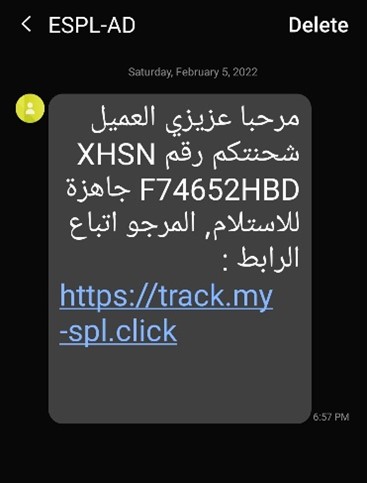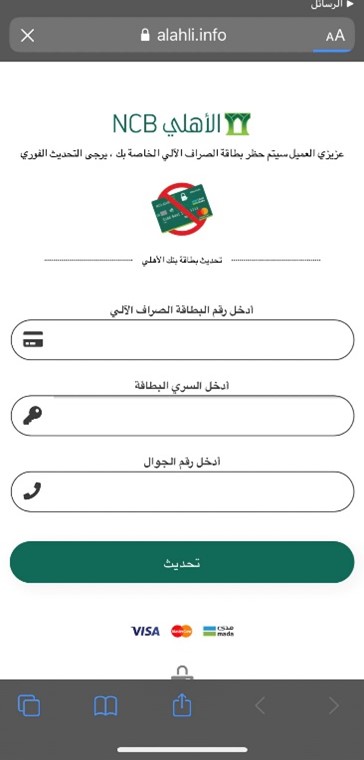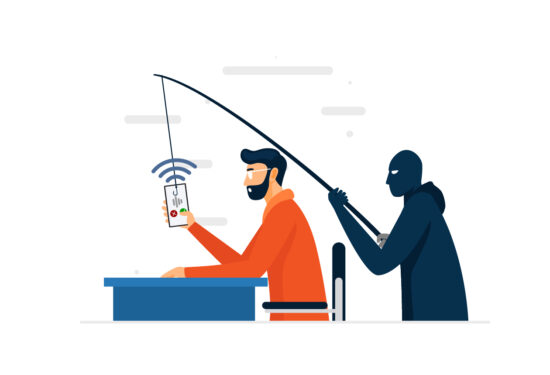Did you know that there are 6.648 billion (83.72%) people worldwide who own a mobile phone and in Saudi Arabia alone, 97.5% of its society owns one? Also, did you know that the average time people spend on their phones is 3 hours and 43 minutes? What if you knew that they are all vulnerable to fraud attacks via Smishing!
With most of the world connected to their mobile phones on a daily basis, this incited cyber criminals to level up their SMS phishing attacks .

Smishing Attacks Trends
It’s no wonder that the number of smishing attacks has increased in the last couple of years. In 2021, 74% of enterprises were targeted by smishing attacks, a 13% more increase than increase over 2020. Individuals receive an average of 13 text messages a day, and the probability of one of those messages being a smishing attack is high (Zipwhip’s The 2021 state of texting Report).
To avoid being a victim of this attack, awareness is key. Unfortunately, last year when people were quizzed about their awareness of smishing, only 23% of them answered correctly, a surprising 8% less than the year before.
So, how are these cyber criminals currently luring in their victims?
Current Smishing Trends
1- Smishing via Delivery service-related messages
Delivery service-related messages have always been the number one topic for SMS, email, and voice phishing attacks.

It’s only logical that as eCommerce grows, so does the number of online shoppers around the world. The number of online shoppers is estimated to be 2.14 billion in 2021.
Over the last few years, the number of online shoppers has increased. As internet connectivity grows around the world and online purchasing becomes more convenient, this growth should come as no surprise.
Receiving a text message from a delivery service company will not be something a person would be suspicious of since they are waiting for their online order to be delivered especially when it is received during the holidays. But an attentive person would quickly notice the indictors of a fake text message. When receiving an SMS from a company, they will never use a personal phone number or have incorrect grammar or structure. So, be on the lookout for these signs.
*This is an example of a fake delivery message disguised as the Saudi Post (SPL). once the person clicks on the link and enters their card details, then you have been officially compromised.
2- Smishing Via Messages claiming to be from the bank.
When you receive an alarming message stating that a significant amount of money had been withdrawn from your account, then you would panic and interact with the message blindly.
This has resulted in many instances where people have had malware installed on to their phone due to the text message it is containing a link to “resolve the problem”. The mistake of taking action without caution is the downfall of many.
With contactless payment methods being on the rise, there have been many incidents where people receive a message from “Apple” warning them that their Apple pay wallet has been deactivated and should click on the link to reactivate.
With this convincing Apple Pay text scam, hackers are attempting to phish consumers of their personal information. Apple has warned of this scam and asks its users to always sign into their account to double-check if there really is a problem.


*An example of fake SMS text claiming to be from a Saudi Bank ( AlAhli NCB) First of all, no bank sends from a personal phone number. The link attached is a fake website that can steal your information or cause malware to be installed on your device.
3- Marketing-related messages claiming you’ve won a prize.
Have you ever received a text informing you that you’ve won a prize or a voucher to something you’ve never interacted with but urges you to quickly visit their website by clicking the link attached? If yes, then hopefully you haven’t clicked anything on the message. The first indicator that this is a scam is that you received a message from something you didn’t register for or a brand you didn’t interact with.
This way is commonly used by cybercriminals so they can pull you in by claiming that you’ve won a chance for a free coupon and all you need to do is click on a link and enter your information. As soon as you click on the click your device and info has been compromised.

*As you can see here, a person was sent a text message full of spelling errors from private number claiming they have won a prize. This is a prime and clear example of Smishing.
4- Receiving text messages claiming to be from a government entity
Since the beginning of the COVD-19 outbreak, governments have been contacting their recipients via SMS to notify them of any urgent news or updates, since text messages are the fastest way to reach people.
These messages usually contain a link redirecting to a phishing website urging people to fill out a form claiming to be a mandatory step for every citizen. Sadly, these messages are still being sent and many are falling into these traps due to them not examining the sender and the content of the message thoroughly.
Find out more about phishing trends with us..
Be careful before clicking anything!
Share this article:
Popular

Tips To Be Cyber Protected While Traveling
Goodbye worry! A safe journey in the digital world With all the modern wonders of the digital world, we trust communication technologies on our journeys. There is no doubt that the travel experience is always more beautiful and enjoyable, but it can also pose a range of risks, especially when it comes to cybersecurity. Travelers may fall victim to phishing, Wi-Fi network spying, and theft of their personal data, which can make their journey filled with worries and tension. With the increasing prevalence of cyber threats, it is essential for travelers to follow some guidelines to protect their devices and ...
1st Apr 2024
Push Authentication: A New Era in Multi-Factor Authentication
Want To Say Goodbye To Passwords and OTP Codes? Discover Push Authentication! It is easy for your password to be compromised through phishing attacks, even if it meets the cybersecurity strong password standards and is difficult to predict So we must get to know the technique of Push based Authentication. Some may recommend that you use Multi-Factor Authentication (MFA) to increase your security. Multi-Factor Authentication (MFA): MFA is the process of logging into your account through multiple steps. It requires you to enter more information, not just your password. But there is another obstacle that arises when using such ...
14th Feb 2024
The Difference Between Phishing Attacks
The Difference Between Phishing Attacks Phishing attacks are harmful attacks used by criminals to steal personal and financial information from individuals and businesses. Attacks on individuals and businesses are becoming more common as we use the internet and technology more often in our daily lives. Phishing attacks involve the use of dishonesty and fraudulent methods to fool consumers into believing they are interacting with the trustworthiness of an unsuspecting destination, such as banks, email companies, or social media platforms. But what is the difference between phishing attacks? How can individuals and organizations protect themselves from such attacks? That is what ...
17th Jul 2023
Understanding of the Vishing Meaning
Understanding of the Vishing Meaning Vishing, a combination of “voice” and “phishing,” is a sophisticated form of cybercrime that exploits voice communication to trick individuals and extract sensitive information. In this comprehensive guide, we will explore the meaning of it, the dangers associated with it, and effective methods to protect yourself against these malicious attacks. What is Vishing meaning? Vishing refers to the fraudulent practice of using telephone services to trick individuals into revealing personal and financial information. Scammers often pose as trusted organizations or individuals to gain their victims’ trust. By using social engineering tactics and manipulating ...
5th Jul 2023
How could Artificial Intelligence tools threaten cybersecurity
How could Artificial Intelligence tools threaten cybersecurity? As Artificial Intelligence Tools become more sophisticated, they can be used to launch cyber attacks that are more complex and difficult to detect. In this article, we will explore how AI tools could threaten cybersecurity and what measures can be taken to mitigate these threats. Artificial Intelligence (AI) became popular today, and it is one of the most important terminologies in our current era, though it has been around since the 1950s. AI relies on the development of systems and technologies that help to do tasks by the simulation of human intelligence ...
11th May 2023
Cerebra is participating at GISEC 2023
We are thrilled to announce that we are going to GISEC 2023 and would like you to join us! Visit Cerebra at GISEC 2023 Hall #4 stand SP62 in Dubai World Trade Center from 14-16 March. GISEC Global is the leading gathering ground for the cybersecurity community worldwide. Top cybersecurity enterprises from 40 countries, CISOs from major corporations across the Middle East, Africa & Asia, government dignitaries and cyber leaders, regional and international innovators, and global experts collaborated to lead cybersecurity transformations across sectors and nations decisively. Get a chance to preview our latest Cybersecurity products: PhishGuard is the Phishing stimulations solution that raises the employees cybersecurity awareness ...
13th Mar 2023
6 Tips to create a strong password easily!
Create a strong password easily! Today it’s very important to everyone who have an account either on social media or any other websites or services to Create a strong password, because you have to treat your password as your best stuff’s and protect it from others. Learn now the easiest and best tips you have to follow to make a strong password.. What is Password? A password is a string of characters that provides access to a digital system or service. It is a crucial security measure that helps to protect sensitive information from unauthorized access. Passwords can be as simple as a word ...
1st Feb 2023
Employees and cyber security: dangerous statistics about Phishing
Employees and cyber security The relationship between employees and cyber security this days must be tight and your company have to give it the right care if you want to keep your data and your business secure.. According to insights from our leading Phishing simulation tool PhishGuard, 58% of users in Saudi Arabia have opened at least one phishing email. These insights reveal that at least one out of four employees have interacted with a phishing email, either by clicking on a link or downloading a malicious attachment. In some cases, employees have gone further and submitted their personal information ...
26th Oct 2022
LinQ2’s Participation at CITC Digital Technology Forum 2022
We are happy to announce that our product LinQ2, has been chosen to participate in CITC annual Digital Technology Forum, in addition to being nominated for the Top Technical Product award. The theme of this year’s forum is “Enabling Local Technology Products“. The Communication & Information Technology Commission (CITC) has recognized our efforts and achievements with our enterprise messaging gateway LinQ2. As our product can seamlessly and securely process messages from and to applications and systems, as well as have the ability to integrate with different channels and connection options. We at Cerebra continuously strive to become one of the ...
20th Oct 2022







